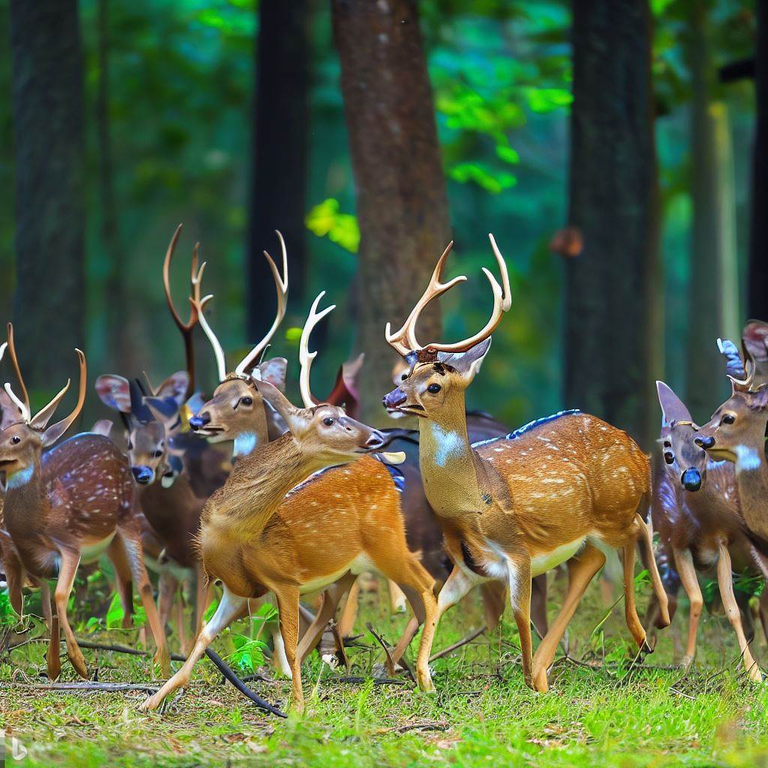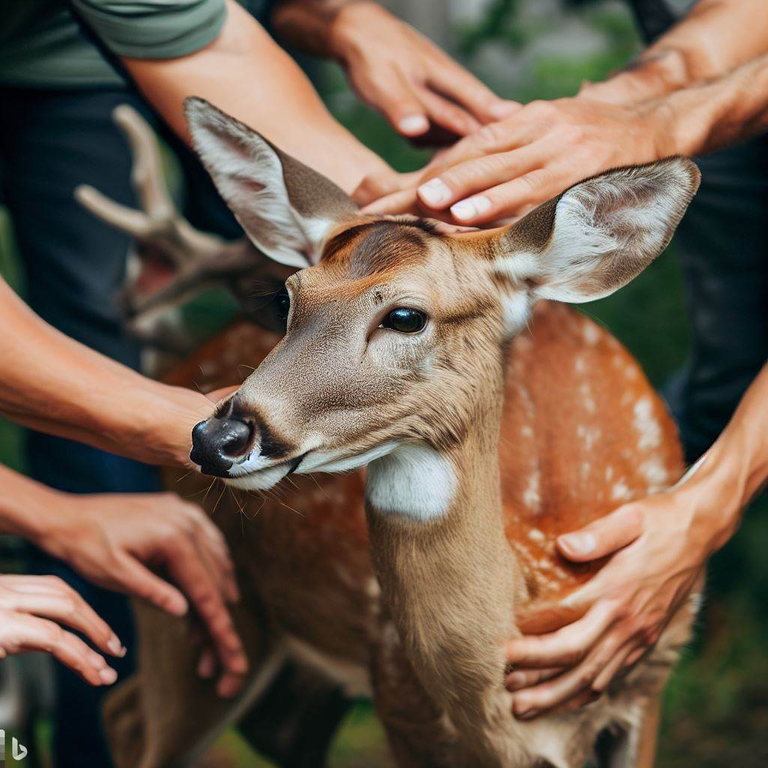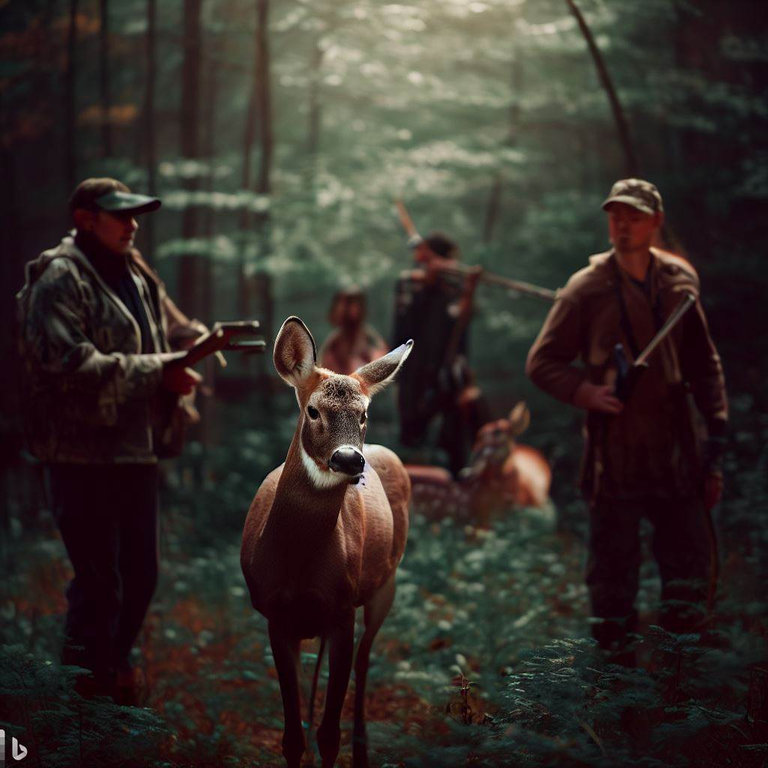Adaptation, Hunting, and Survival: The Saga of White-Tailed Deer in the World
Certain animals are distinctive in our biological context and our cultural imagination. The white-tailed deer symbolizes elegance, perseverance, and the long-standing relationship between humans and animals. It's found in North American woodlands, the European countryside, and beyond. The story of the white-tailed deer combines evolutionary miracles, cultural relevance, and conservation.
These fascinating species have shaped prehistory and society. From their prehistoric forebears traversing ancient landscapes to their contacts with Native American cultures, from the start of European discovery to the present problems of conservation, white-tailed deer history illuminates human relationships with nature.
This article explores the fascinating global history of white-tailed deer. We'll explore these gorgeous animals' evolutionary beginnings, their impact on Native American societies, European colonisation, and current conservation issues. Join us as we explore the white-tailed deer's amazing narrative, which spans countries and centuries.
Distribution and Evolution
Let's examine the white-tailed deer's evolution and range. Over millions of years, these amazing organisms have adapted to many conditions and spread around the world.
The white-tailed deer evolved millions of years ago. Their forefathers traversed Eurasia. Early deer species had distinct adaptations to survive in varied settings.
White-tailed deer are known for their gorgeous white tails. Deer communicate and warn with this tail. These evolutionary qualities have helped them survive and thrive, along with their strong senses, remarkable agility, and efficient digestion system.
During the glacial period, these extraordinary deer species crossed the Asia-North America land bridge. They migrated to North America and discovered new possibilities and resources. They gradually adapted to the continent's many environments, from deep forests to broad plains.
White-tailed deer are widespread in North and South America, Europe, and Asia. They stretch from southern Canada to northern South America in North America. They have colonised woods, pastures, and even suburbs due to their adaptability.
White-tailed deer have flourished in many places, although their distribution has varied throughout time. Climate change, habitat degradation, and humans have affected their numbers and ranges. However, their resilience to adapt and survive shows their species' resilience.
That's the white-tailed deer's evolution and distribution. These gorgeous creatures continue to amaze us with their extraordinary history and ability to adapt to a changing world.
Indigenous Influence
Let's look at how white-tailed deer shaped Native American traditions. These amazing animals shaped indigenous Americans' customs, subsistence, and spiritual beliefs.
White-tailed deer were more than food for Native Americans. They symbolised plenty, flexibility, and connectivity with nature. Tribes revered these animals for their significance in everyday life and community survival.
Native American tribes needed white-tailed deer meat, skins, and bones. It went beyond nourishment. These societies were deeply rooted in deer hunting. Rituals, rites, and community endeavours promoted togetherness and shared responsibility.
Native Americans mastered deer hunting. They developed tracking skills, learned deer behaviour, and employed various tactics to hunt successfully. This wisdom, handed down through generations, fostered relationships and connections to nature.
Native American religion reveres deer. Many tribes thought deer had spiritual attributes like agility, elegance, and attentiveness. They connected to nature and the animal spirit via deer dances, rituals, and storytelling.
The white-tailed deer helped the Native American economy. Tribes traded deer skins, antlers, and other deer-derived items with neighbouring tribes, creating relationships and commercial transactions.
Native Americans understood the balance between hunting and conservation. They hunted sustainably to protect deer numbers for future generations.
Native American culture affects white-tailed deer conservation today. Their traditions, tales, and ecological wisdom continue to affect our understanding of these species in nature.

European Colonization
Let's explore the intriguing European discovery and colonization of white-tailed deer. European explorers' experiences with America's native white-tailed deer changed how humans interacted with these amazing animals.
European explorers found various animals, including white-tailed deer, in the Americas. These elegant creatures wandering the woodlands and meadows created an unforgettable impact on the explorers, who considered them a precious resource and a possible source of money.
European settlers changed human-white-tailed deer connections. European colonies relied on hunting for food, trade, and economic progress. European settlers wanted deer skins and meat for profit.
European colonization greatly affected Native American relationships with white-tailed deer. European invaders invaded indigenous territory, disturbing hunting and ecological equilibrium. This affected deer numbers and Native American tribes' centuries-old spiritual and cultural ties to them.
White-tailed deer were hunted more as populations grew. Deer skins and venison drove a vibrant commerce business. Exploitation, deforestation, and habitat destruction reduced deer numbers in several areas.
But not all European settlers hunted deer the same way. Sustainable practises were needed to maintain deer numbers. Hunting rules were created to balance hunting and conservation.
As the US and Canada acquired independence and developed, white-tailed deer perceptions changed. Wildlife management originated from conservation movements and a growing knowledge of deer's ecological relevance.
Many nations restrict white-tailed deer shooting with seasons and bag limits to control numbers and assure sustainability. European exploration and colonisation affected deer conservation and hunting.
19th century–present

From Bing
Let's go from the 19th century to the present, a time when white-tailed deer faced both problems and successes. Deer numbers, hunting, conservation, and our awareness of their ecological importance changed during this century.
Human settlements, industrialization, and westward expansion in North America changed white-tailed deer habitats in the 19th century. Forests were destroyed for cultivation, fragmenting deer habitats. Unregulated subsistence and market hunting for deer goods endangered these animals.
As deer populations suffered, views changed. Wildlife conservation gained momentum. In the early 20th century, wildlife management programmes and hunting prohibitions restored and maintained deer numbers.
White-tailed deer reintroduction and recovery were successes at this time. Restoration was done in deer-depleted regions. Translocations, habitat restoration, and tougher hunting rules helped deer rebound.
National parks also provide protection for white-tailed deer. These conservation strongholds allowed deer populations to persist in relatively undisturbed areas.
Research on white-tailed deer ecology, behavior, and population dynamics has advanced in the 20th and 21st centuries. Wildlife management practises currently combine deer population demands with habitat integrity.
Challenges remain. Especially in urban areas, habitat loss and fragmentation pose a threat to white-tailed deer populations. Deer overpopulation has caused problems with farmers and more deer-vehicle incidents.
Deer fertility control and adaptive management are being investigated to solve these issues. Sustainable solutions that balance human requirements and white-tailed deer populations need collaboration between wildlife authorities, conservation organizations, and communities.
White-tailed deer history reminds us of the necessity of conservation efforts today and in the future. Human-wildlife relations have changed as a result of challenges and successes from the 19th century to the present. We must protect white-tailed deer so they can continue to amaze and enrich our natural world.
Cultural Importance
White-tailed deer have fascinating cultural importance. These beautiful animals have shaped folklore, mythology, hunting practises, and even economic and ecological systems.
White-tailed deer have featured in folklore and mythology throughout civilization. Their grace, agility, and flexibility make them beautiful. They symbolise power, endurance, and regeneration in stories. These creatures have captivated humans everywhere, from Native American deer spirits to European magical deer.
Many hunting cultures center around white-tailed deer. Hunting these animals is a rite of passage and a source of income for communities. Deer hunting traditions include seasons, tracking methods, and information exchange.
White-tailed deer are economically important. Many locations profit from hunting outfitters, lodges, deer viewing, and hunting tourism. Equipment, apparel, and hunting and wildlife-related enterprises benefit. Rural economies benefit from white-tailed deer.
White-tailed deer are important ecologically. By grazing and scattering seeds, they modify the terrain. Their diets support forest regeneration and biodiversity. They also provide prey for predators, maintaining environmental equilibrium.
White-tailed deer symbolize our strong connection to nature. These species have influenced our identities, cultures, and economies. They represent the complex interaction between humans, animals, and the environment.
Conservation Issues
Let's examine current white-tailed deer hazards and conservation issues. Despite their versatility and endurance, these wonderful species face several threats to their numbers and habitats.
Habitat degradation and fragmentation threaten white-tailed deer. Deer's once-vast woods and grasslands are fragmenting as human populations grow and land is used for agriculture, urban construction, and infrastructure. This fragmentation reduces their food, water, and shelter, interrupts migration patterns, and makes them more vulnerable to predators and accidents.
Overhunting and poaching threaten white-tailed deer numbers. Unregulated hunting depletes local populations, disrupts social dynamics, and reduces genetic diversity. Poaching for deer goods or the pleasure of illicit shooting exacerbates these issues.
Disease is another major issue. CWD and EHD can infect white-tailed deer. These illnesses may decimate deer herds, harming their health and reproduction.
Invasive species can also upset white-tailed deer habitats. Invasive predators and plants can increase deer predation pressure and change feed availability.
Deer management in human-dominated settings complicates conservation efforts. Suburban deer overpopulation can cause problems with humans, agricultural and garden damage, and deer-vehicle incidents.
These risks and conservation issues necessitate a diverse strategy. Conservation organisations, wildlife authorities, and communities work to manage animals sustainably. This involves hunting rules, habitat protection, restoration, monitoring, and disease control.
Public awareness and education encourage stewardship and responsible interactions with white-tailed deer. Individuals may help conservation efforts by knowing these critters' ecological relevance and conservation problems.
White-tailed deer face several risks, but determined efforts and a common commitment to their protection give hope. We can protect these wonderful animals for future generations by tackling habitat loss, overhunting, illnesses, and human cohabitation.
Present and Future
Let's examine the white-tailed deer's state and prospects. Understanding where we are and what lies ahead is essential to protecting these wonderful species.
White-tailed deer populations worldwide are diverse. Thanks to protection and good habitat, their numbers are thriving in certain areas. Hunting programmes, predator-prey dynamics, and disease control are usually well managed in these locations.

Image from bing
White-tailed deer have considerable issues elsewhere. Their populations face habitat loss, fragmentation, and urbanisation. Overabundance can cause ecological imbalances, crop loss, and deer-vehicle accidents. Chronic wasting illness also threatens deer numbers.
These obstacles and effective conservation strategies will determine the white-tailed deer's future. We can protect these magnificent animals by concentrating on critical regions.
Habitat conservation and restoration come first. White-tailed deer need extensive, contiguous ecosystems to survive. This involves conserving ecosystems, constructing animal corridors, and supporting sustainable land use.
Deer management is crucial. Maintaining healthy deer populations requires scientific hunting restrictions, sustainable harvest practises, and population monitoring. Fertility control programmes can also lessen deer conflicts and harmful effects in suburban and urban environments.
Diseases, especially chronic wasting illnesses, must be addressed. To control these illnesses in deer populations, research, early discovery, and appropriate management are needed.
Public participation and education promote white-tailed deer cohabitation and responsibility. Awareness of these species' ecological value, cultural significance, and conservation concerns might motivate individuals, communities, and governments to support conservation efforts.
Despite hurdles, there is optimism. Many regions have seen excellent results from conservation organizations, wildlife authorities, and communities. Continued habitat protection, sustainable management, disease control, and public participation may help white-tailed deer thrive across their range.
White-tailed deer depend on our conservation efforts. We can secure a bright and lasting future for these amazing species on our ever-changing planet by acknowledging their ecological and cultural value and adopting effective conservation efforts.
References
- Wildlife | Encyclopedia.com. www.encyclopedia.com/earth-and-environment/ecology-and-environmentalism/environmental-studies/wildlife.
- Hancock, Elaina. “White-tailed Deer Bones Give a Glimpse Into Connecticut’s Past and May Help Inform a More Sustainable Future - UConn Today.” UConn Today, 6 July 2023, today.uconn.edu/2023/05/white-tailed-deer-bones-give-a-glimpse-into-connecticuts-past-and-may-help-inform-a-more-sustainable-future.
- Smith, Sanford S. White-Tailed Deer. extension.psu.edu/white-tailed-deer.
- Keehner, Jon R., et al. “Conservation Value, History and Legal Status of Non-Native White-Tailed Deer (Odocoileus Virginianus) on the Caribbean Island of St. Kitts.” Tropical Conservation Science, SAGE Publishing, 1 June 2016, https://doi.org/10.1177/194008291600900212.
- Hunters and the Conservation and Management of White-tailed Deer | Caesar Kleberg Wildlife Research Institute. www.ckwri.tamuk.edu/news-events/hunters-and-conservation-and-management-white-tailed-deer.
- “White-Tailed Deer Adaptations.” Pets on Mom.com, 19 Nov. 2020, animals.mom.com/whitetailed-deer-adaptations-10660.html.
- Anirudh. “White-tailed Deer - Facts, Habitat, Range, Diet, Adaptations, and Pictures.” Animal Spot, 13 Dec. 2021, www.animalspot.net/white-tailed-deer.html.
- “White-Tailed Deer | National Geographic.” Animals, www.nationalgeographic.com/animals/mammals/facts/white-tailed-deer.
-“White-tailed Deer.” Wikipedia, 10 July 2023, en.wikipedia.org/wiki/White-tailed_deer. - Faunalytics. “How Deer Adapt to Hunting Activity.” Faunalytics, 29 Sept. 2022, faunalytics.org/deer-adapt-hunting-activity.
- Cosleyzoo. “White-tailed Deer.” Cosley Zoo, cosleyzoo.org/white-tailed-deer.



Quite really a nice fairly tale ☺️
Thanks for your contribution to the STEMsocial community. Feel free to join us on discord to get to know the rest of us!
Please consider delegating to the @stemsocial account (85% of the curation rewards are returned).
You may also include @stemsocial as a beneficiary of the rewards of this post to get a stronger support.
Congratulations @jsalvage! You have completed the following achievement on the Hive blockchain And have been rewarded with New badge(s)
Your next target is to reach 75000 upvotes.
You can view your badges on your board and compare yourself to others in the Ranking
If you no longer want to receive notifications, reply to this comment with the word
STOPCheck out our last posts:
Dear @jsalvage !
I feel sad that I read your good article today!
I thought you claimed that the white-tailed deer of North America became an important food source for people!
I agree with your point!
By the way, I wonder what is the most important wildlife in Nigeria!😄
With its 2019 launch, AGM Global Vision https://www.agmglobalvision.com/thermal-imaging/thermal-monoculars has quickly risen to the top of the electro-optics sector. Thanks to the expertise of long-term employees, AGM has become a household name in the world of digital optics, thermal imaging, and night vision systems. From versatile day/night alternatives to thermal imaging systems for firearms, their product portfolio covers a lot of ground. They have established themselves as market leaders because to their extensive global distribution network, which covers over 100 countries. If you're looking for something fresh, give AGM's innovative optical solutions a go!